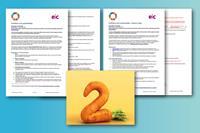Fertilisers, both inorganic and organic, have a part to play in successful sustainable food production
The ability to perform a chemistry practical safely is a key skill, assessed as part of 16–18 chemistry courses in the UK and Republic of Ireland. This activity gives learners an opportunity to practise these skills, in the context of fertilisers and the sustainability of their manufacture and use.
The practical itself, rates of hydrolysis of urea, and the calculation and conclusion questions are aimed at learners in their second year of a 16–18 chemistry course. Additional questions on fertiliser sustainability that accompany the practical add context. These could also be used with 14–16 learners. The practical experiment is part of our Challenging plants: fertilisers practicals.

Sustainability in chemistry

This resource accompanies the Education in Chemistry article Link global food security to your lessons on fertilisers where you will find more support and suggestions for how to connect your current chemistry teaching with UN sustainable development goal 2: end hunger, achieve food security and improved nutrition, and promote sustainable agriculture. Link directly to the goal to give this activity an engaging and relevant context.
Teacher notes
The full set of resources to support this practical investigation comprises:
For the practical investigation
- Student sheet containing instructions for completing a practical on the rate of hydrolysis of urea.
- Teacher and technician sheet with some information about the background chemistry and equipment list.
To assess practical skills and add context
- Teacher notes with guidance for each part of the experiment and answers to the questions in the student worksheet.
- Student worksheet with additional questions based on the practical to help with assessment of practical skills and additional green chemistry questions, linking fertiliser to UN sustainable development goal 2.
- Grid for assessing the practical using CPACs (suitable for those following English curriculums).
Learning objectives
- Design an experiment to collect data to measure the rate of hydrolysis of urea.
- Carry out, analyse and conclude using gathered data, for an experiment to measure the rate of hydrolysis of urea.
- Use collected experimental data to identify the initial rate of hydrolysis of urea, find the order of reaction, write a rate equation and identify a rate determining step.
- Use a mathematical model for describing rates of reaction and use a graph to find half-life.
- Expand on the use of fertilisers linking to UN sustainable development goal 2.
This resource contains suggestions for assessing most of the practical skills for the write-up of a complete investigation. You could decide to just assess part of the practical, in which case the learning objectives and worksheets can be adjusted to give more or less information.
Differentiation
This activity is well suited to all learners, regardless of prior attainment. Some learners may require additional support in terms of further detail or prompts, to develop their practical skills.
The additional questions help learners to link their understanding of fertilisers and sustainability beyond the syllabus.
Link fertilisers to your lessons on global food security and enrich your teaching in this topic area with the UN sustainable development goal 15 (restore and promote sustainable use of terrestrial ecosystems, halt biodiversity loss and halt and reverse land degradation) article in this series.
Find more resources
- Our Challenging plants series includes many resources and practical investigations on plant science, soil science and fertilisers.
- Use our lesson plan on ‘Healthy’ fats and obesity with your 16–18 learners, which includes an experiment comparing saturated and unsaturated fats.
- Link to careers with this job profile of a research and development team leader reducing food waste through better packaging and this video profile of a head of research and sustainability, who makes a sustainable fabric from pineapple leaves!
- Test and observe whether everyday foodstuffs contain starch using this microscale experiment, which only takes 10 minutes!
- Vitamins and the chemistry behind them provides your 11–16 learners with scientific and historical contexts and includes practical experiments, lesson plans and a DART (Directed Activity Related to Text).
Downloads
Fertilisers and sustainability: teacher notes
Handout | PDF, Size 0.38 mbFertilisers and sustainability: teacher notes
Editable handout | Word, Size 0.25 mbFertilisers and sustainability: student worksheet
Handout | PDF, Size 0.18 mbFertilisers and sustainability: student worksheet
Editable handout | Word, Size 0.14 mbCPAC assessment grid
Handout | PDF, Size 0.12 mbCPAC assessment grid
Editable handout | Word, Size 35.96 kb



















No comments yet